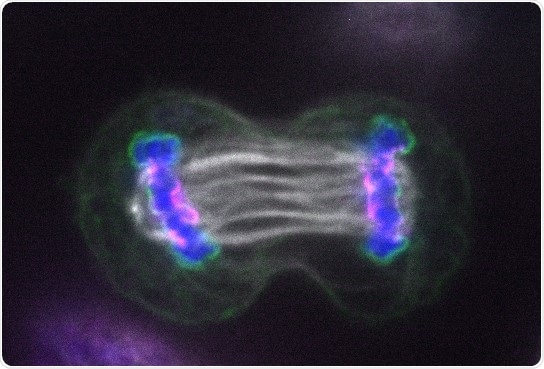The body replaces aging and damaged cells by mainly using a process known as mitosis, wherein a single cell splits into two cells.

To visualize LEM2’s role in mitosis, the Ullman Lab used colored fluorescent markers to label the different components: LEM2, the fibers, and the DNA. Image Credit: Huntsman Cancer Institute.
When a single cell is set to divide, it undergoes DNA duplication so that a complete copy exists for each of the daughter cells. In this biological process, the pieces of DNA, or chromosomes, should be accurately distributed within the daughter cells.
If a single cell has an incomplete DNA copy, or if the DNA becomes impaired, it can lead to genetic diseases and disorders like cancer.
Cell division can take place only when two sets of DNA are localized to the cell’s opposite sides. First, the compartment that generally comprises the DNA, that is, the nucleus, breaks its protective coating. Following this, the chromosomes are isolated by an apparatus of fibers.
Each set of DNA is surrounded by a newly formed nucleus. Finally, the cell divides into two, each containing its own re-formed nuclear compartment.
Researchers from Huntsman Cancer Institute (HCI) at the University of Utah (U of U) and their colleagues at the University of California, San Francisco (UCSF) have published a study in the Nature journal that extends ones’ interpretation of the complex process of cell division.
The researchers observed that a protein called LEM2 has two major functions during cell division.
Initially, the LEM2 protein produces seals in the protective coating of the developing nuclei that protects the two DNA sets from damage. Secondly, the LEM2 protein recruits factors that break the apparatus of fibers that cause the separation of the two sets of DNA.
HCI’s Katharine Ullman, Ph.D., and UCSF’s Adam Frost, Ph.D., teamed up over the last six years on this study.
To view the role of LEM2 in mitosis, Ullman Lab utilized colored fluorescent markers to mark different components, namely, the DNA, LEM2, and the fibers. This process enabled the researchers to image the LEM2 protein from when it initially associates with the intact fibers until the time of their disintegration.
The researchers observed how the LEM2 proteins concentrated and formed a gel-like seal with other types of proteins (ESCRTs) at holes where fibers pass over the nucleus’ protective coat. This LEM2 “O-ring” successfully sealed off the re-formation of a nuclear coat, protecting each of the DNA set from a material encapsulating the nucleus.
Using our imaging methods, we were able to see a process that only occurs over the course of about five minutes during cell division, something that would have been very difficult to study otherwise.”
Dollie LaJoie, PhD, Study Co-Author and Researcher, Huntsman Cancer Institute
LaJoie is a scientist in Ullman’s research team.
Ullman continued, “This work was strengthened by the fact that both teams worked on this project using different approaches to better explain the role of LEM2. My research group focused on this process in live cells while Frost’s research group worked to understand more about the protein itself.”
The authors observed that this new type of gel-like separation may prove significant for other major cell functions in which LEM2 is also involved, including the organization of higher-level DNAs.
The authors also showed that any disruptions caused to the LEM2 protein while it assembles the nucleus lead to DNA damage, which can considerably impact normal cell function.
This work opens a door to identifying new pathways for DNA to be damaged, which in some cases may contribute to the development of cancer.”
Katharine Ullman, PhD, Huntsman Cancer Institute
Going forward, the Ullman and Frost Labs will further develop the study by examining the link between the improper formation of nucleus and DNA damage. The researchers will also assess how the cancer cells are likely to lack the regulation of nuclear assembly as well as nuclear repair.
Source:
Journal reference:
Von Appen, A., et al. (2020) LEM2 phase separation promotes ESCRT-mediated nuclear envelope reformation. Nature. doi.org/10.1038/s41586-020-2232-x.